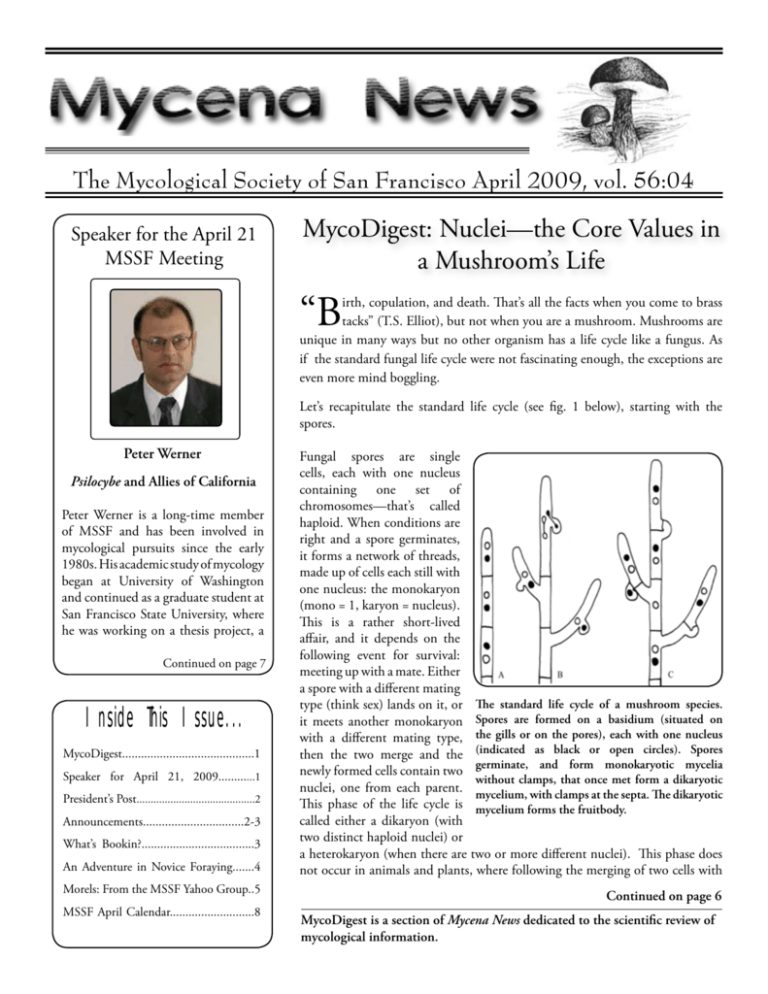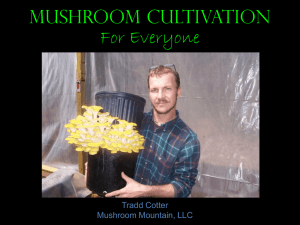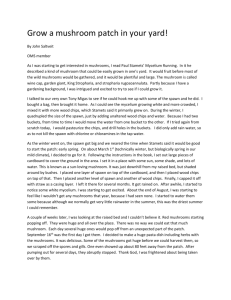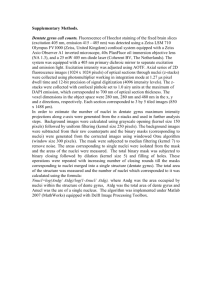April, 2009 - Mycological Society of San Francisco
advertisement

The Mycological Society of San Francisco April 2009, vol. 56:04 Speaker for the April 21 MSSF Meeting MycoDigest: Nuclei—the Core Values in a Mushroom’s Life “B irth, copulation, and death. That’s all the facts when you come to brass tacks” (T.S. Elliot), but not when you are a mushroom. Mushrooms are unique in many ways but no other organism has a life cycle like a fungus. As if the standard fungal life cycle were not fascinating enough, the exceptions are even more mind boggling. Let’s recapitulate the standard life cycle (see fig. 1 below), starting with the spores. Peter Werner Psilocybe and Allies of California Peter Werner is a long-time member of MSSF and has been involved in mycological pursuits since the early 1980s. His academic study of mycology began at University of Washington and continued as a graduate student at San Francisco State University, where he was working on a thesis project, a Continued on page 7 Inside This Issue... MycoDigest..........................................1 Speaker for April 21, 2009............1 President’s Post..........................................2 Announcements................................2-3 What’s Bookin?....................................3 An Adventure in Novice Foraying.......4 Morels: From the MSSF Yahoo Group..5 MSSF April Calendar...........................8 Fungal spores are single cells, each with one nucleus containing one set of chromosomes—that’s called haploid. When conditions are right and a spore germinates, it forms a network of threads, made up of cells each still with one nucleus: the monokaryon (mono = 1, karyon = nucleus). This is a rather short-lived affair, and it depends on the following event for survival: meeting up with a mate. Either a spore with a different mating type (think sex) lands on it, or The standard life cycle of a mushroom species. it meets another monokaryon Spores are formed on a basidium (situated on with a different mating type, the gills or on the pores), each with one nucleus then the two merge and the (indicated as black or open circles). Spores germinate, and form monokaryotic mycelia newly formed cells contain two without clamps, that once met form a dikaryotic nuclei, one from each parent. mycelium, with clamps at the septa. The dikaryotic This phase of the life cycle is mycelium forms the fruitbody. called either a dikaryon (with two distinct haploid nuclei) or a heterokaryon (when there are two or more different nuclei). This phase does not occur in animals and plants, where following the merging of two cells with Continued on page 6 MycoDigest is a section of Mycena News dedicated to the scientific review of mycological information. The Mycena News, April 2009 Page 2 PRESIDENT’S POST W hat a strange year it has been! Weather-wise, I mean. First, we have a summer where we saw California nearly completely burn up (I’ll come back to this later). Then the autumn season began hopefully with a couple of storms in November, but soon the spigot stopped and dry conditions set in for the long haul. I was a bit worried about the Fungus Fair since there was no rain at least two weeks beforehand. Fortunately, there was enough residual moisture, plus lots of terrific volunteers who brought fungi from as far away as the Sierra Nevada foothills and Salt Point State Park, that we had a very good collection of material—over 300 species that were identified at the Fair—with significant quantities of some species (Amanita calyptrata, coccora, comes to mind). I also have heard that several people had a decent bolete season. Then, nothing in terms of precipitation for two months! Temperatures in the 80’s at times. Yow! Finally, in February we had significant rain. The main casualty seems to have been chanterelles. I think they just gave up after awhile with no precipitation and couldn’t recover even after it started raining again. The word is that black trumpets are popping in places, so at least the season isn’t a total bust. Announcements Annual Elections Coming in May Elections for next year’s officers will be help at the May 19th “Annual Meeting” of the MSSF. The Nominees are: President: Dan Long Vice-President: Lou Prestia Secretary: Phil Brown (incumbent) Treasurer: Henry Shaw (incumbent) Councilors: George Willis (incumbent) and David Gardella Other nominations may be made in writing, signed by 5 members of the MSSF, and presented to the Secretary on or before May 19th. Retiring President J.R. Blair will take a seat on the council as Past President. The other council seats are filled by committee chairs who are appointed by the President. Mushroom Hunting Talk and Walk April 8, 10 So, about those fires. As you probably know, the western United States’ best morel fruitings occur in spring the mountains that had burned the previous summer or fall. As expected our club will take advantage of the multitudinous potential morel locations this spring. The first weekend in May is our annual San Jose Camp Foray. San Jose Camp is located off Highway 120 west of Yosemite. The accommodations are tent cabins and all meals are provided by the camp kitchen. See the notice in this newsletter and/or the website for more information. Our Foray Chairperson, Norm Andresen, has scheduled a camping foray the following weekend at a location to be announced, depending on where morels are being found at the time. Again, details are elsewhere. So, get out there and find the little devils. Cal Hiking and Outdoor Society presents the 4th sort-of-annual slideshow and hike (or foray, as we foragers call it) Speaking of San Jose Camp, I’d like to make a note of tremendous gratitude to a member who has been one our most reliable volunteers, Tom Sasaki. Up until this year Tom has organized the San Jose Camp Foray for a long time (can’t tell you exactly but a long time). Councilor Phil Harben has graciously taken the job this year. Tom was the President of the Society in 1976, has always been a great help with the Fungus Fair and other events, for two or three years he arranged mushroom identification slide shows, courtesy of the North American Mycological Association, before our General Meetings, and I’m sure he’s done many things of which I am unaware. Thank you, Tom. You’re an inspiration and a gentleman. Continued to the right Hunting the Wild Mushroom Tips for Beginners on How to Get Started and Not Get Poisoned Slideshow: 8pm Wed. April 8th, 101 Wheeler Hall, UC Berkeley Campus Beginner Mushroom Hike: 10am Sat. April 11th, Joaquin Miller Park, Oakland If you are an experienced mushroomer willing to lead a small group on the foray, please contact Dave Lubertozzi at dluber1@berkeley.edu Good hunting! J.R. Blair The Mycena News, April 2009 Page 3 What’s Bookin? T his month I am presenting a great book. “Morels” by: Michael Kuo. It is published by the University of Michigan Press. “Michael Kuo offers an engaging survey of a diverse group of fungi whose fruiting bodies are among the most prized edible mushrooms. Morels is a lavishly illustrated poem that will be relished by amateur and professional mycologists alike.” Michael Kuo, an English teacher in Illinois, is the developer of mushroomexpert.com, a popular online resource for mushroom identification and morel hunting. This book contains over two hundred color photographs. This book will be available for sale for $5.00 at the next MSSF general meeting. Don’t forget to mention you are a MSSF member in good standing and receive your 10% discount. ~Curt Haney MSSF Book Chairperson San Jose Camp Spring Morel Foray Is Coming Up T his year the annual MSSF event will take place May 1-3. Cost is $120 / person for members, $140 for non-members, half price for children 4-12 years old, and free for children 3 and under. The fee includes a tent cabin for 2 nights, Friday dinner, all meals on Saturday, and breakfast & lunch on Sunday as well as all activities. On Saturday night Brian Perry will be our featured speaker. He will speak about his current work on fungal bioluminescence, and will also discuss the Spring Ascomycetes of the Sierra Nevada. More information on Brian’s research interests and background can be found by following the link: http://userwww.sfsu.edu/ ~baperry/biolumin.html. The late rains and reasonably large snowpack this year bode well for the timing of the foray. As further details on the event are worked out they will be posted on the MSSF web site. To reserve, send checks payable to MSSF to Phil Harben, 817 South G Street, Livermore, CA 94550. Please include an email address for reservation confirmation and follow-up details. April 2009, vol. 60:04 Contributors: Norm Andresen, J.R. Blair, David Campbell, Robin Gao, Pat George, Curt Haney, Phil Harben, Sam Longmire, David Lubertozzi, Fred Stevens, Else Vellinga, Peter Werner Kristopher Woyshner Editing and Layout: Jeffrey Fisher Mycena News is the member’s newsletter of the Mycological Society of San Francisco, and is published monthly from September through May. Please e-mail photos, comments, corrections, and correspondence to mycenanews@mssf.org. To subscribe, renew, or make address changes, please contact Alvaro Carvajal: alvaro.carvajal@ sbcglobal.net or (415) 695-0466. Past issues of Mycena News can be read on-line at www.mssf.org. MSSF Officers 2008-2009 President: J.R. Blair (650) 728-9405 jrblair@mssf.org Vice President: Dan Long (925) 945-6477 danlong@astound.net Secretary: Phil Brown (510) 526-4325 towltek2000@msn.com Treasurer: Henry Shaw 925-551-8243 hfshaw@yahoo.com The Mycena News, April 2009 Page 4 An Adventure in Novice Mushroom Hunting Robin Gao and Kristopher Woyshner A s novices, we are as much into discovering where mushrooms grow as we are into creating dishes for the variety of mushrooms that we do find in and around Boston. On one frosty day last October, we took a trip out of the city to hike a mountain in New Hampshire. We had two friends and our standard hunting gear: a reusable shopping bag and a small paring knife. we have secured a new spot to gather mushrooms. And soon after this adventure, we acquired a mushroom identification guide which now accompanies us on our trips! • Not long after we started crunching through layers of radiant autumnal leaves, our eyes fell on what looked to be shelves of oyster mushrooms growing on tree trunks all around us. Our excitement redoubled and our stomachs tingled at this first hint of an imminent, delectable feast. But when we went to pick them, we were surprised that they were as hard as rocks! Confused, we quickly realized that the mushrooms had succumbed to the frigid autumn. We picked them anyway, and with the help of our friends who soon got caught up in the excitement of the hunt, had the opportunity to pick many more as they appeared along our path. Serves 4 - 6 Our ascent into the coniferous zone of the mountain brought us to the end of our hunting luck; fortunately, our bag was filled halfway and we were quite satisfied with our haul. We took opportunities to relish other aspects of this day: we shed our coats and basked in sunlight upon flattened grasses, and at the summit, we enjoyed a simple picnic of rice noodles with vegetables, and took a siesta on sun-drenched rocks overlooking western New Hampshire. After the descent, and in anticipation of the preparation of our oysters, we purchased a block of cheese in a small country store just over the border in Vermont. Though we were fairly confident that we had collected oyster mushrooms, we did not have a field guide during our hunt, so we returned with the intention of making a positive identification using online sources. This technique provided inconclusive results because of our lack of experience in mushroom identification. Determined to not let our hard work and excitement go to waste, we both agreed we would cook the mushrooms anyway. We did the responsible thing by preparing handwritten living wills, allocating possessions of questionable worth to our friends and loved ones. A simple and quick meal was prepared by sautéing the mushrooms with garlic and olive oil, and tossing them with pasta and tomato sauce. There was an air of uncertainty as we sat down to eat, not knowing if this was going to be our last meal or the start of a major appreciation for the melt-in-yourmouth oyster mushroom. Happily, our intuition proved correct and not only did we enjoy a delicious and nourishing dinner, Mushroom Risotto By: Kristopher Woyshner Ingredients: 3 Tbsp butter (for cooking onions) 1 ¼ C chopped onion 1 ¼ C Carnaroli or Arborio rice ¾ C dry white wine 3 ½ C mushroom stock 1 pound sautéed fresh wild mushrooms ½ C grated parmesan cheese 3 Tbsp C heavy cream 2 Tbsp cold butter (to stir in at the end) ¼ C chopped fresh herbs (parsley, chervil, tarragon) Salt and pepper to taste Instructions: First, prepare your mushroom stock. This can be made any number of ways, but I like to take whatever mushrooms I have in abundance and simmer them for a few hours in water with a carrot or leek and a few parsley stems. Alternately, you can make a stock by re-hydrating some dried mushrooms, which also works well. Next, prepare your fresh mushrooms by sautéing them in vegetable oil until they are tender and then letting them cool. To start the risotto, use a heavy bottom pan and set it over medium heat. Melt the butter in this pan and gently cook the chopped onions. Do not brown the onions, but cook until the onions start to become translucent. As soon as the onions are done cooking, stir in the rice and cook for a couple minutes—this will toast the rice a bit. Then add the wine all at once, and it will sizzle and bubble in the pot. Once the wine has evaporated, begin adding the heated mushroom stock in small batches, while constantly stirring the rice throughout this process. Continue to slowly add batches of mushroom stock until the rice becomes al dente. Thanks to Robin Gao for getting in touch and sharing a glimpse of mushrooming in New England! The Mycena News, April 2009 Page 5 Excerpts from a Recent Discussion About Morels on the MSSF Yahoo Group Conditions: P ark ranger stations should be able to tell you where controlled burns and logging areas are, and perhaps most importantly, the condition of the unpaved roads in those areas. I went looking last May in the Angora burn, and found none, and later around Ice House lake, where we found a few. It was a very dry spring, however, so pretty much the only water available was from snowmelt, and with high temps and sunny days, it seemed like the soil went immediately from too cold to too dry, without a phase in between at the proper temp and moisture. First Year Burns, Second Year Burns, and Logging Areas: I have done much more hunting in second year sites than first year sites. I agree that moisture is key. I’ve even found several dozen [morels] in a burned-over, peat-like wetland where every step made an oozing, squishing, sucking sound. North slopes are typically better, in my experience. -Sam Longmire I go to second year burns out of desperation, like when there are no first year burns. They are a better bet than unburned woods, in general, but will likely have diminished production compared to the first year, all things being Angora Ridge looked like a equal, which, of course, they moonscape—ashes and charcoal, never are. Logging activity only a few saprophytic plants certainly increases potential for (although we did find some tasty the second year, but there you Gyromitras at the edge of the have it, now we are talking more snowfields) whereas at Ice House about morels responding to the trees were just a bit toasted, logging disturbance as opposed and there was lots of half-burned to morels growing directly as downed wood and new greenery a result of fire aftermath. As under foot, even some surviving a side note, “natural” morels pine duff—found some Spring are often the morel of record Kings also. in logging debris. They fruit at colder temperatures than “burn” The fact that we did find some morels, thus tending to show up fungi near Ice House in a lightly earlier in the season. This can be Morchella deliciosa. Photo by Fred Stevens burned area, vs. almost none in important when we’re suffering Angora makes me wonder—can our all too frequent too cold or it be too burned? too dry springs. The naturals -David Lubertozzi have bailed my morel season more than once with their ability to fruit with earlier rains, as presumably prime burn habitat Regarding too burned: where a large pile has been burned, later ended up laying fallow when Sierra rains petered out such as at a logging project landing site, I never find morels prematurely. In any event, given viable habitat, morel fruiting in the middle—only at the edges and in the disturbed areas is all about having sufficient moisture present when soil nearby. I think it can be too burned, but I’d be interested to temperatures come up to snuff... hear experience to the contrary. -David Campbell -Sam Longmire The degree of burning is less important than the moisture and temperature. I have picked morels from ash, but the humidity and soil moisture were just right. I think that ground cover, from needles or leaves, does give the morels a better shot at surviving low humidity.The down side to picking in ash is that large rain drops splash ash onto the morels, which can make them dirt balls on a stick. -Norm Andresen These posts have been edited for clarity and grammar. Every attempt has been made to maintain the writer’s own voice and intended meaning. -Eds. • Page 6 The Mycena News, April 2009 MycoDigest continued single nuclei from different parents, the nuclei fuse and the genetic material is mixed to form an offspring that differs from the parents. A mating type can be compared to gender as we know it in animals, but in many cases there are not just two mating types in equal proportions, but many, increasing the possibility of meeting a mate. And a second note to the story above, the cells of the monokaryon are separated from each other by a simple wall; those of the dikaryon have a special structure that makes sure that with every cell division a copy of both nuclei gets moved on to the new cell, this is the clamp (see fig. 2 below). Monokaryons lack clamps. —recombination happens, and two new nuclei are formed. Another nuclear division, this time without changes in the contents of each nucleus, produces a total of four nuclei which are moved to the four budding spores each on top of a little prong (sterigma) of the basidium. The life cycle is complete. For many species we do not know the details of this life cycle; it is not too hard to count nuclei in the cells of a fruitbody, but mycelium is harder to find, and in many cases hard to grow. And, what it actually means when there are two (or three or ten) nuclei in a stipe cell is another issue. We do know, just from observations, that there are quite a few exceptions to the standard life cycle described above. Even the ‘lab rat’ Coprinopsis cinerea has variations on this life cycle, as it can form asexual spores on the monokaryon and the dikaryon, it can also sit out bad times as a sclerotium, an asexual resting structure, or a thick-walled resting spore, again sprouted from both stages, and, the four spores on the basidium have two identical nuclei each. When two compatible monokaryons meet, the cells merge, and the nuclei of one of them moves into the mycelium of the other, cell walls crumble, and the ‘invading’ nucleus divides and moves quickly along, a speed of two mm per hour has been noted, until all the cells are provided with Honey mushrooms have two nuclei, and a truly not read the text books dikaryotic mycelium either and follow strange continues to grow, with and different paths (see the proper use of clamp Brian Perry’s article connections to move The role of clamps in the distribution of the nuclei. A. A hypha that has just on genetic mosaics); the two nuclei into been provided with a second nucleus per cell, and does not have clamps. B. The one aberrant road they new cells. (And don’t cells are growing and dividing, and so are the nuclei, one of the two daughter follow is that the nuclei nucleis moves into the clamp. C. Cells have divided, and the clamps have moved be awkward and ask me can fuse already in the the nuclei into the next cell. After Buller (1930). what happens when two mycelium phase, making mating events happen at the mycelium diploid different parts of a monokaryotic mycelium and propagating (the spores of ‘normal’ mushroom species are haploid, and the dikaryotic waves meet in the middle.) mycelium is provided with two separate haploid spores per cell), long before the formation of fruitbodies, the place where The two nuclei in the cells of the dikaryon work together to diploidization takes place in other mushroom species. get the cell’s machinery going. This dikaryotic mycelium is long lived, and can form the fruitbodies – our mushrooms A meeting between a monokaryon and a dikaryon can also – when the conditions are right. And that is where genetic result in a happy ending—with one of the two nuclei of the recombination – a reshuffling of the genetic material of the dikaryon moving into the monokaryon, but migration in parents – takes place. Place of action is in the basidia, the special the opposite direction has also been observed, resulting in a cells on the gills of your Amanita, inside the tubes of the porcini trikaryon. or red belted conk, or on the branches of a Ramaria species. The two nuclei of the dikaryon fuse to form one nucleus with Just like Coprinopsis cinerea, most Lepiota species have an two sets of chromosomes—now we can call the cell diploid Continued on page 7 The Mycena News, April 2009 Page 7 MycoDigest continued additional division of the nuclei inside the spores, and two identical nuclei are present in each spore. This is a widespread phenomenon among mushroom species. The situation in which two different nuclei per cell are present happens too, but is much rarer. The button mushroom, Agaricus bisporus, with only two spores per basidium, has spores with four nuclei each, of two different mating types; it produces mycelium with four nuclei per cell (but three or five nuclei also happen), and skips the mating of the mycelium part of the cycle as an unnecessary and messy procedure, as each cell has already two different nuclei. The cells just under the basidia and the basidia themselves have 2 nuclei, one of each type, and with a meiotic and two mitotic (normal) nuclear divisions, two spores each with four nuclei are formed. Clamp connections are absent—all Agaricus species lack them as a matter of fact—nevertheless, nuclei divide and are moved from one cell to the next without any problem. Recent research on a species of Annosum root rot (Heterobasidion parviporum) shows that there can be even more going on. Monokaryons were grown in the lab and different types were mated in a Petri dish. The heterokaryotic stage of this fungus, after the mating of the two monokaryons, has cells with a multitude of nuclei each. Furthermore, these nuclei do, in many cases, not occur in 1:1 proportions, but with one type dominant over the other. If one of the parents is a monokaryon that is sick and old, its nuclei dominate the heterokaryon heavily, and can outnumber the other type of nuclei nine to one. Asexual, monokaryotic spores (conidia) are formed on the heterokaryons, but the number of nuclei of one type in a heterokaryon is not a predictor for the type of nucleus that will make it into these conidia. Different growth media also may influence which nucleus type will be most numerous in a mycelium. And on top of all that, there is no correlation between the presence of clamp connections (which varies from 5 to 100%) and the skewedness in the proportions of nucleus types. In fact, many fungi have a heterokaryotic phase, with cells with more than one copy of each nuclear type, but in most cases, they grow out of it, and when it comes to the formation of a fruitbody, the organism is back to the normal situation of two nuclei per cell. All evidence in the Heterobasidion example indicates that selection does not work on the organism as a whole but at the level of the nucleus. Of course, lots of questions are still open—how widespread is this phenomenon, what is the role of clamps, are these imbalanced proportions maintained throughout the mycelium and other parts of the lifecycle, how do the nuclei operate the cell’s daily life, is there a division of labour, would it be possible to follow the different nuclei in the mycelium? And, still, this is only one aspect of the intriguing life cycle of mushrooms. • Further reading: Boidin, J., 1971. Nuclear behavior in the mycelium and the evolution of the Basidiomycetes. In: R.H. Petersen (ed.). Evolution in the higher Basidiomycetes: 129-148. The University of Tennessee Press, Knoxville. Buller, A.H.R., 1930. The biological significance of conjugate nuclei in Coprinus lagopus and other Hymenomycetes. Nature 126 (3183): 686-688. Callac, P., C. Spataro, A. Caille & M. Imbernon, 2006. Evidence for outcrossing via the Buller Phenomenon in a substrate simultaneously inoculated with spores and mycelium of Agaricus bisporus. Applied and environmental microbiology 72: 2366-2372. Horton, T.R., 2006. The number of nuclei in basidiospores of 63 species of ectomycorrhizal Homobasidiomycetes. Mycologia 98: 233-238. James, T.Y., J. Stenlid, Å. Olson & H. Johannesson, 2008. Evolutionary significance of imbalanced nuclear ratios within heterokaryons of the basidiomycete fungus Heterobasidion parviporum. Evolution 62: 2279-2296. James, T.Y., S. Johansson & H. Johannesson, 2009 (on line early). Trikaryon formation and nuclear selection in pairings between heterokaryons and homokaryons of the root rot pathogen Heterobasidion parviporum. Mycological Research in press. Kamzolkina, O.V., V.N. Volkova, M.V. Kozlova, E.V. Pancheva, Y.T. Dyakov & P. Callac, 2006. Karylogocal evidence for meiosis in the different types of life cycles existing in Agaricus bisporus. Mycologia 98: 763-770. Perry, B., 2007. Are mushrooms genetic individuals or genetic mosaics? Mycena News 58 (09): 1, 6-7. Speaker continued monograph of the Psilocybe species of California under advisor Dennis Desjardin. Peter is also an avid photographer and microscopist, and recently completed a professional certification program in microscopy at Merritt College. Peter will be speaking on Psilocybe and allies of California, as well as other psilocybin mushrooms of the state. His talk will include discussion of recently-discovered species from California, as well as the taxonomic issues surrounding the classification and naming of Psilocybe and its relatives. First Class Mail U.S. Postage PAID Oakland, CA Permit No. 1451 Mycological Society of San Francisco c/o The Randall Museum 199 Museum Way San Francisco, CA 94114 April 2009, vol. 60:04 MSSF Calendar, April 2009 Monday, April 6, 2009, 7pm, Culinary Group Dinner. We meet at the Hall of Flowers, Golden Gate Park, 9th and Lincoln, San Francisco. Reservations are required. Contact Pat George at (510) 204-9130 or plgeorge33@yahoo.com no later than Friday, April 3rd to make your reservation. Our always outstanding dinners are $14.00 per person and include appetizers, punch, the main and sides, dessert and coffee. Do remember to bring your tableware, beverage and an appetizer to share. The dining area can be accessed from the employee parking lot located off Lincoln behind the building. The entrance to that parking area is just past 9th going west. The dining area can also be accessed from the front area of the Hall to the left as you face it. Our next dinner, the last of this mushroom season, will be on May 4th. Saturday, April 18, 2009. Cal Day at UC Berkeley. MSSF will have a display at the herbarium in the Life Sciences Building. Many other free events will take place at UC Berkeley on this day. Tuesday, April 21, 2009. MSSF General Meeting. Randall Museum. 7pm, mushroom identification and refreshments provided by the Hospitality Committee. 8pm, Peter Werner will discuss the Psilocybe and Allies of California. Friday, May 1–Sunday, May 3. Annual San Jose Camp Spring Morel Foray. Cost is $120 / person for members, $140 for non-members, half price for children 4-12 years old, and free for children 3 and under. The fee includes a tent cabin for 2 nights, Friday dinner, all meals on Saturday, and breakfast & lunch on Sunday as well as all activities. To reserve, send checks payable to MSSF to Phil Harben, 817 South G Street, Livermore, CA 94550. Please include an email address for reservation confirmation and follow-up details. See article on page 3 for more information. Deadline for the May 2009 issue of Mycena News is April 15. Please send your articles, calendar items, and other information to: mycenanews@mssf.org








